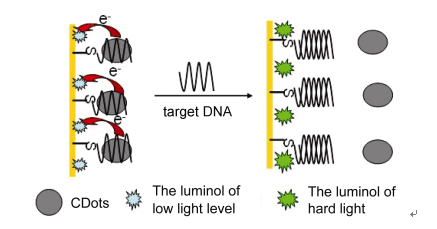| [1] Li, J.; Guo, S. J.; Wang, E. K. RSC Adv. 2012, 2, 3579.[2] Zhang, Z. F.; Cui, H.; Lai, C. Z.; Shi, M. J. Anal. Chem. 2005, 77, 3324.[3] Guo, J. Z.; Cui, H.; Zhou, W.; Wang, W. J. Photochem. Photobiol. A: Chem. 2008, 193, 89.[4] Chen, H.; Gao, F.; He, R.; Cui, D. X. J. Colloid Interface Sci. 2007, 315, 158.[5] Xu, S. L.; Cui, H. Luminescence 2007, 22, 77.[6] Duan, R.; Zhou, X.; Xing, D. Anal. Chem. 2010, 82, 3099.[7] Pinijsuwan, S.; Rijiravanich, P.; Somasundrum, M.; Surareung-chai, W. Anal. Chem. 2008, 80, 6779.[8] Jie, G.; Zhang, J.; Wang, D.; Cheng, C.; Chen, H. Y.; Zhu, J. J. Anal. Chem. 2008, 80, 4033.[9] Duan, R.; Zhou, X.; Xing, D. Anal. Chem. 2010, 82, 3099.[10] Xu, S. J.; Liu, Y.; Wang, T. H.; Li, J. H. Anal. Chem. 2011, 83, 3817.[11] Ding, Z. B.; Quinn, M. S.; Haram, K.; Pell, L. E.; Korgel, B. A.; Bard, A. J. Science 2002, 296, 1293.[12] Diez, I.; Pusa, M.; Kulmala, S.; Jiang, H.; Walther, A.; Goldmann, A. S.; Mu? ller, A. H. E.; Ikkala, O.; Ras, R. H. A. Angew. Chem., Int. Ed. 2009, 48, 2122.[13] Li, L.; Liu, H.; Shen, Y.; Zhang, J.; Zhu, J.-J. Anal. Chem. 2011, 83, 661.[14] Fang, Y.-M.; Song, J.; Li, J.; Wang, Y.-W.; Yang, H.-H.; Sun, J.-J.; Chen, G.-N. Chem. Commun. 2011, 47, 2369.[15] Baker, S. N.; Baker, G. A. Angew. Chem., Int. Ed. 2010, 49, 6726.[16] Li, H. L.; Zhang, Y. W.; Wang, L.; Tian, J. Q.; Sun, X. P. Chem. Commun. 2011, 47, 961.[17] Ouyang, X. Y.; Liu, J. H.; Li, J. S.; Yang, R. H. Chem. Commun. 2012, 48, 88.[18] Li, H. L.; Zhai, J. F.; Sun, X. P. Langmuir 2011, 27, 4305.[19] Bai, W. J.; Zheng, H. Z.; Long, Y. J.; Mao, X. J.; Gao, M.; Zhang, L. Y. Anal. Sci. 2011, 27, 243.[20] Lao, R. J.; Song, S. P.; Wu, H. P.; Wang, L. H.; Zhang, Z. Z.; He, L.; Fan, C. H. Anal. Chem. 2005, 77, 6475.[21] Zhu, H.; Wang, X. L.; Li, Y. L.; Wang, Z. J.; Yang, F.; Yang, X. R. Chem. Commun. 2009, (34), 5118. |
